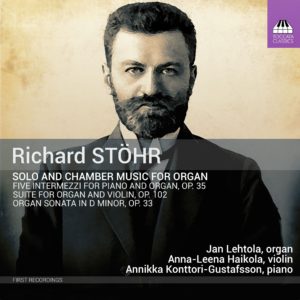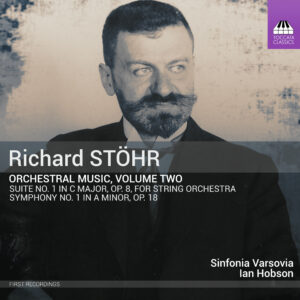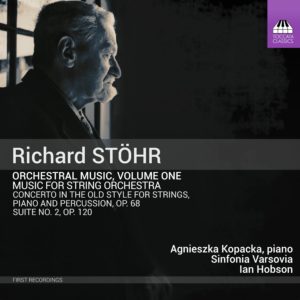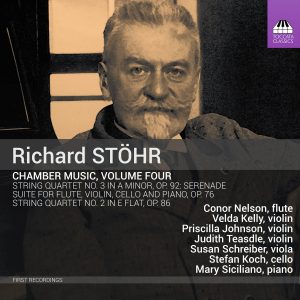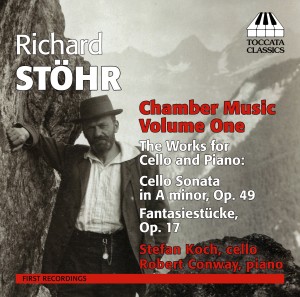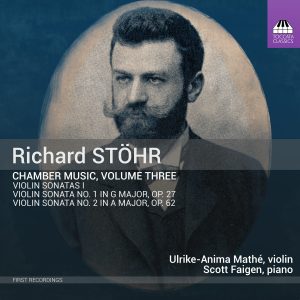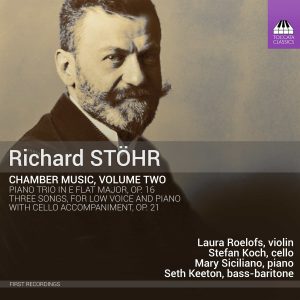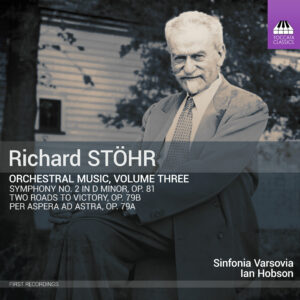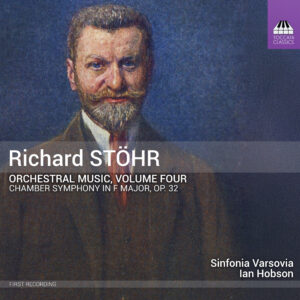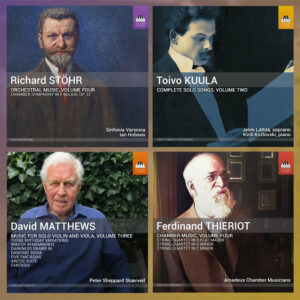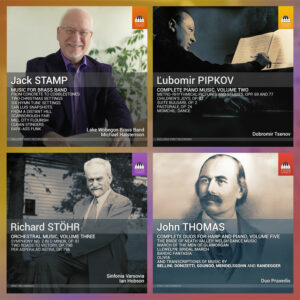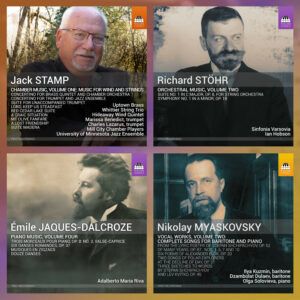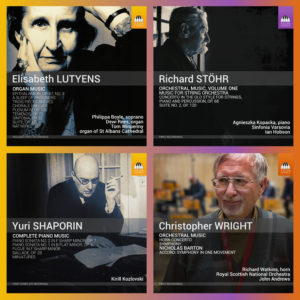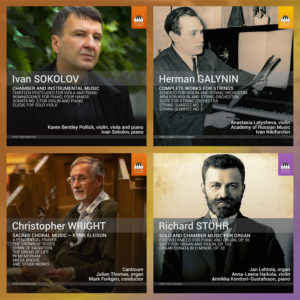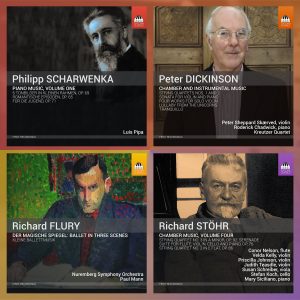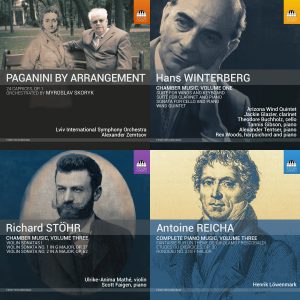Search Results for "stöhr"
Richard Stöhr: Solo and Chamber Music for Organ
Like Korngold, Toch, Schoenberg, Zeisl and Zemlinsky, Richard Stöhr (1874–1967) was one of many Austrian composers driven into American exile by the Nazis. His generous output of music, being rediscovered at last in these Toccata Classics recordings, includes seven symphonies, much chamber music, songs, and choral and piano pieces. His output for organ is not extensive, but its quality is high: the instrument plays an important role in a number of Stöhr’s orchestral works, and here Stöhr presents the organ in two thoroughly attractive duos and an imposing solo sonata. The Sonata and Intermezzi sit downstream from Brahms in the tradition of Viennese classicism; the chromatic touches in the later Suite lean towards the language of Korngold.
Jan Lehtola, organ
Anna-Leena Haikola, violin
Annikka Konttori-Gustafsson, piano
First recordings
Richard Stöhr: Orchestral Music, Volume Two
This second volume of the orchestral music of the Austro- American composer Richard Stöhr (1874–1967) reveals further marvels: the first of his two suites for string orchestra encases a moving slow movement between a charming prelude and an elegant fugue; and the four imposing spans of the expansive First Symphony offer grandeur and heartfelt profundity – as well as irresistibly catchy tunes that will set the foot tapping. Stöhr writes in a musical language somewhere between Bruckner, Mahler and his exact Viennese contemporary Franz Schmidt – but it is a voice increasingly readily recognised as his own.
Sinfonia Varsovia
Piotr Wilczyński, organ
Ian Hobson
Richard Stöhr: Orchestral Music, Volume One: Music for String Orchestra
These two works for string orchestra were composed on either side of the flight of the Viennese composer Richard Stöhr (1874–1967) from occupied Austria to the USA, and from prominence and danger to liberty and obscurity, and they reflect the change in his circumstances: the Concerto in the Old Style is expansive, witty, energetic and endlessly good-natured, whereas the Second Suite is introspective, understated and deeply felt. These first recordings allow the discovery of two major additions to the repertoire for strings; the Second Suite is also one of the last grand statements of late Romanticism.
Agnieszka Kopacka, piano (Tracks 1–4)
Sinfonia Varsovia
Ian Hobson, conductor
Richard STÖHR: Chamber Music, Volume Four
Like Korngold, Toch, Schoenberg, Zeisl and Zemlinsky, Richard Stöhr (1874–1967) was another Austrian composer driven into American exile by the Nazis. His generous output of music, being rediscovered at last in these Toccata Classics recordings, includes seven symphonies, much chamber music, songs, and choral and piano pieces. These chamber works, from his first years in the United States, show him in surprisingly relaxed mood, the Viennese lyricism of his native city maintained in his US refuge.
Stefan Koch, cello
Conor Nelson, (Tracks flute 1 – 4)
Velda Kelly, (Tracks violin 1 – 4)
Priscilla Johnson, (Tracks violin 5 – 9)
Judith Teasdle, (Tracks violin 5 – 9)
Susan Schreiber, (Tracks viola 5 – 9)
Mary Siciliano (Tracks 1 – 4)
Richard Stöhr: Chamber Music, Volume One
Like Korngold, Schoenberg, Zeisl and Zemlinsky, Richard Stöhr (1874-1967) was another Austrian composer driven into American exile by the Nazis. His generous output of music — ripe for rediscovery — includes seven symphonies, fifteen violin sonatas among much other chamber music, songs, and choral and piano pieces. His two works for cello and piano — the four Fantasiestücke of 1907 and a Sonata from 1915, recorded here in the first of a series devoted to Stöhr's music — reveal a composer with a lyrical and expressive language downstream from Brahms and Schumann.
Stefan Koch, cello
Robert Conway, piano
Richard Stöhr: Chamber Music, Volume Three: Violin Sonatas I
Like Korngold, Schoenberg, Toch, Zeisl and Zemlinsky, Richard Stöhr (1874–1967) was another Austrian composer driven into American exile by the Nazis. His generous output of music, being rediscovered at last in these Toccata Classics recordings, includes seven symphonies, much chamber music, songs, and choral and piano pieces. The first two of his fifteen violin sonatas offer a seamless outpouring of fin de siècle Viennese lyricism, with one good tune following another, in a style somewhere between Brahms and Korngold.
Ulrike-Anima Mathé, violin
Scott Faigen, piano
Richard Stöhr: Chamber Music, Volume Two
Like Korngold, Toch, Schoenberg, Zeisl and Zemlinsky, Richard Stöhr (1874–1967) was another Austrian composer driven into American exile by the Nazis. His generous output of music – ripe for rediscovery – includes seven symphonies, fifteen violin sonatas among much other chamber music, songs, and choral and piano pieces. His expansive E flat Piano Trio of 1905 sits firmly in the Viennese Romantic tradition downstream from Schubert and Brahms, with one lovely tune following another, whereas the Three Songs, written only four years later, look forward to the lyrical intensity of Korngold.
Laura Roelofs, violin (Tracks 1-4)
Stefan Koch, cello
Mary Siciliano, piano
Seth Keeton, bass-baritone (Tracks 5-7)
Richard Stöhr: Orchestral Music, Volume Three
Like so many important Austrian musicians forced into American exile by the Nazis, Richard Stöhr (1874–1967) suddenly found himself cast from celebrity into obscurity, The optimism and energy, even defiance, of these three works from 1942 suggest that he took it in his stride, with his musical language retaining its Viennese accent in an individual amalgam of Bruckner, Mahler, Schmidt and Korngold. Indeed, the echoes of Mahler in Stöhr’s Second Symphony may be a deliberate homage if, as seems possible, this score is a revision of a now-lost work first composed shortly after Mahler’s death.
Sinfonia Varsovia
Ian Hobson, conductor
Richard Stöhr: Orchestral Music, Volume Four
From the early days of the twentieth century until the Anschluss forced him into American exile, Richard Stöhr (1874–1967) was one of the more prominent personalities in Viennese musical life, as composer, teacher and author. Earlier releases in this series of recordings revealed him to have an individual voice, somewhere between Bruckner, Mahler, Korngold and Strauss. It can be heard in its full glory in his Chamber Symphony of 1912, a sunlit score modest in its orchestral demands but expansive in its ambit and generous in its ceaseless flow of gorgeous melody.
Sinfonia Varsovia
Ian Hobson, conductor
November 2025 Toccata Classics Bundle
Included in this bundle:
- Richard Stöhr: Orchestral Music, Volume Four
- David Matthews: Music for Solo Violin and Viola, Volume Three
- Toivo Kuula: Complete Solo Songs, Volume Two
- Ferdinand Thieriot: Chamber Music, Volume Four
November 2024 Bundle
Included in this bundle:
July 2023 Bundle
Included in this bundle:
May 2022 Bundle
Included in this bundle:
August 2020 Bundle
Included in this bundle:
January 2020 Bundle
Included in this bundle:
Stay In the Know
JOIN THE TOCCATA NEWSLETTER
"*" indicates required fields
By visiting our site, you agree to our privacy policy regarding cookies, tracking statistics, etc.
